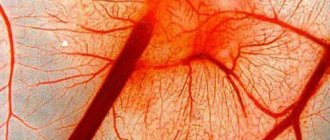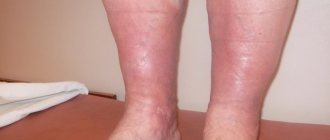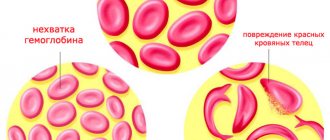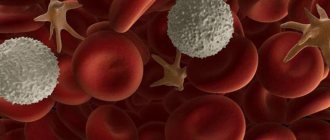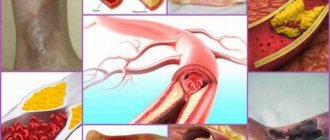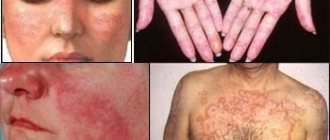Raynaud's disease is one of the most mysterious diseases that affects about 5% of the world's population. It was first described in 1862 by French physician, scientist and educator Maurice Raynaud , who observed a girl suffering from sudden attacks of numbness in her limbs. Based on an analysis of five similar cases, the author concluded that these symptoms belonged to a new, previously unknown disease, and described in detail all its symptoms.
The disease manifests itself as sudden attacks of spasm in the small arteries of the arms and/or legs, and sometimes in other peripheral parts of the body - the tip of the nose and ears. As a result, blood ceases to flow in sufficient quantities to the cells of these parts of the body, leading to the development of so-called ischemia (bleeding). As a rule, this is preceded by hypothermia or severe stress. As the disease progresses, it can eventually lead to a serious complication - gangrene of the fingers.
Most often, the disease occurs in residents of cold climates and mainly affects middle-aged people (40-50 years old). Raynaud's syndrome occurs 4 times more often in women than in men.
1 General blood test
2 Diagnosis of Raynaud's syndrome
3 Diagnosis of Raynaud's syndrome
When talking about this disease, we mean two types of pathology: Raynaud's disease and Raynaud's syndrome .
Raynaud's disease is considered an independent disease with an unknown cause.
Raynaud's syndrome may be a manifestation of any other underlying diseases. When they talk about Raynaud's phenomenon, they most often (in most patients) mean Raynaud's syndrome. And only 15% of patients have an independent disease with the same name.
A mandatory sign of this disease is symmetrical damage to the limbs.
Causes
The causes of Raynaud's disease cannot be considered separately from the mechanism of development of the disease. It is based on organic and functional disorders that affect both the vascular walls and the apparatus responsible for their innervation. As a result, a violation of the nervous regulation of blood vessels occurs, so they react to various influences with spasms, followed by increasing atrophy.
Causes of Raynaud's syndrome:
- Blood viscosity disorders: cryoglobulinemia, polycythemia vera, Waldenström's macroglobulinemia.
- Osteochondrosis of the cervical upper thoracic region.
- Prolonged exposure to vibration during the development of vibration disease.
- Insufficiency of autonomic nervous regulation – syringomyelia.
- Autoimmune diseases affecting connective tissue: systemic lupus erythematosus, systemic scleroderma, rheumatoid polyarteritis nodosa, rheumatism, Sjogren's syndrome, dermatomyositis, periarteritis.
- Vascular diseases are Takashiau disease, obliterating atherosclerosis of the legs, etc.
- Damage to peripheral nerves due to diabetes mellitus (polyneuropathy).
- Intoxication of the body with lead, arsenic salts, cytostatics and ergotamine.
- Disturbances in the functioning of the adrenal glands, thyroid and parathyroid glands.
- Less commonly, Rhine syndrome provokes accessory cervical rib syndrome, carpal tunnel syndrome, and anterior scalene syndrome.
In turn, the causes of Raynaud's disease lie in pathologies of the central nervous system and spinal cord with the involvement of the hypothalamus, brain stem and cortex in this process. These pathological processes lead to the fact that impulses regulating the functioning of blood vessels are transmitted with disturbances.
How to distinguish Raynaud's syndrome from the disease
What is the difference between Raynaud's syndrome and Raynaud's disease? Raynaud's disease is the result of a number of diseases of the central nervous system. They affect the cortex and brain stem, hypothalamus, and spinal cord. In this case, the nervous system suffers, due to which impulses are incorrectly supplied to the vessels from the centers of their formation.
Raynaud's syndrome can be easily identified by the following signs:
- The patient is over 30 years old.
- There are signs of connective tissue pathology.
- The lesions are asymmetrical.
- There are ulcers, necrosis, and sometimes it reaches gangrene.
- High ESR (erythrocyte sedimentation rate).
- Antinuclear antibodies can be detected in the blood.
- Capillaroscopy reveals deformation and reduction (desolation) of capillary loops.
- Vascular crises may occur in internal organs.
- Plethysmography (cooling the fingers and measuring the pressure in the digital artery) reveals a decrease in pressure of more than 70%.
- Laser Doppler scanning reveals a significant decrease in blood flow velocity.
When diagnosed, Raynaud's disease manifests itself in the following symptoms:
- The patient is of any age.
- There are no signs of connective tissue pathologies.
- The lesions are symmetrical.
- There are no ulcers or necrosis.
- ESR is normal.
- There are no antinuclear bodies in the blood.
- During capillaroscopy, no changes in the capillaries are observed.
- Internal organs are not subject to vascular crises.
- Plethysmography does not reveal a decrease in pressure, or this indicator is too insignificant.
- Laser Doppler scanning does not reveal a decrease in blood flow velocity.
Raynaud's disease can only be diagnosed after a thorough and targeted diagnosis. A doctor can make a diagnosis that it is Raynaud's disease only when other diseases with a similar set of symptoms have been excluded.
First signs
Raynaud's disease manifests itself as follows:
- a person’s fingers turn pale;
- there is a tingling sensation;
- limbs go numb;
- the patient's blood flow to the fingers is disrupted, they acquire a bluish tint;
- there is pain in the limbs;
- temperature rises;
- blood pressure increases;
- headaches and dizziness are observed;
- Difficulties arise in coordinating limb movements.
With warming and emotional stability, the symptoms do not go away immediately, the limbs become red in color. These symptoms can also affect not only the limbs, but also the ears, tips of the lips, and the tip of the nose. Raynaud's disease is often accompanied by severe migraines. If these signs appear, you must urgently contact a specialist who will diagnose and recommend adequate treatment for the disease.
Symptoms of Raynaud's syndrome in women
The disease can be primary or secondary, depending on the reasons that caused it.
The secondary form is a complication of other internal pathologies. The most common causes are rheumatological diseases: systemic lupus erythematosus, scleroderma, poliomyositis.
The disease occurs in 3 stages:
- Angiospastic. It manifests itself as a short-term spasm of the blood vessels of the fingers. The spasm passes within a short time. The blood vessels dilate, the fingers become warmer, and the skin turns red.
- Angioparalytic. Fingers and hands acquire a bluish tint, and swelling of the soft tissues is observed.
- Trophoparalytic. Purulent inflammations and ulcers appear on the skin. Foci of superficial necrosis of the soft tissues of the fingers develop. After rejection, long-term non-healing ulcers form.
Raynaud's syndrome in women manifests itself in the form of the following symptoms:
- feeling of chilliness in the hands and feet;
- constantly cold hands and feet;
- numbness and tingling in the fingers;
- pallor and cyanosis of the skin;
- painful sensations in the fingers when moving them;
- the appearance of “bumps” and swelling in the phalanges of the fingers;
- increased dryness of the skin in the affected areas, formation of cracks.
The described disorder is a persistent disorder of the arterial blood supply to the feet, hands, and fingertips. Sometimes the ears, nose and lips are involved in the process. It is important to stop Raynaud's disease in a timely manner - symptoms and treatment become more severe as the pathology progresses. For an unknown reason, the disease in question is more susceptible to young women (the disease occurs 5 times more often than in men) from 20 to 40 years old.
With a deficiency of blood and oxygen, hypoxia of the skin and soft tissues occurs, and their necrosis is observed. In the late stages of Raynaud's disease, the affected areas first become blistered, followed by deep, non-healing ulcers. At best, the tissue will heal, but sometimes it will die and become gangrene. Such complications affect muscles, joints and bones.
Symptoms and stages
The main symptoms of Raynaud's disease in women and men are characterized by predominant damage to the fingers (usually the index, middle and ring fingers, less often the thumb and little finger), manifested by a staged change in the condition of the blood vessels and tissues of the affected area. The severity of these manifestations is determined by the stage of the disease and the duration of its course. Much less commonly affected are other exposed areas of the body (toes, chin, tips of the ears and nose), which are also regularly exposed to cold or heat and other risk factors.
The clinical picture of Raynaud's syndrome includes:
- first stage;
- second stage;
- third stage.
First stage of Raynaud's syndrome
The first stage is also called angiospastic, which is due to the nature of the damage to the blood vessels (that is, their spasm, narrowing). At this stage of development, the first symptoms of the disease appear, which are short-lived.
The first stage of Raynaud's syndrome can manifest itself with the following symptoms:
- Pain. The occurrence of pain is also due to impaired blood circulation in the fingers. The fact is that under normal conditions, the cells of the body constantly release by-products of their vital activity (lactic acid and others), which are carried away with the bloodstream to the place of neutralization in other organs. When arterioles spasm, blood circulation is disrupted, as a result of which metabolic by-products accumulate in the area of formation and lead to pain (pain in this case can be burning, stabbing, aching). After normalization of blood circulation, toxic substances accumulated in large concentrations are carried through the bloodstream into nearby tissues, which can lead to a short-term increase in pain in the phase of reflex vasodilation.
- Change in skin color. It is the first manifestation of the disease. The first occurrence of this symptom is associated with a violation of the nervous and hormonal regulation of vascular tone, which is always caused by the action of provoking or predisposing factors. As a result of a sharp spasm of small blood vessels (arterioles), the blood supply to the vessels decreases. Since the pinkish color of the skin is due to the presence of blood in the capillaries, with vasospasm the skin of the affected area becomes pale in color. A characteristic feature of Raynaud's syndrome is a clear limitation of damage to unaffected areas (a person may feel as if his fingers were dipped in paint). Vascular spasm lasts for a fairly short period of time (2 - 4 minutes), after which their reflex expansion occurs, the vessels overflow with blood and the skin becomes bright red. At this stage, swelling may appear in the joint area, which is due to increased permeability of the vascular walls and the leakage of the liquid part of the blood into the surrounding tissues. Within 10 to 30 minutes, vascular tone is normalized, the skin acquires its normal color and all clinical manifestations disappear.
- Numbness of fingers. Numbness in the affected area occurs as a result of impaired delivery of blood and nutrients to nerve fibers, which are extremely sensitive to hypoxia (lack of oxygen). At the beginning of the attack, the patient may feel a slight tingling sensation or “crawling on the skin” (these symptoms are characteristic of the initial stage of nerve damage), but after a few minutes the sensitivity decreases significantly until it disappears completely.
- Decrease in tissue temperature in the affected area. A constant body temperature is maintained by blood circulation, which heats up as it passes through internal organs (liver, muscles) and cools in the area of the skin and other peripheral tissues. When the blood vessels spasm, blood stops flowing to the area of the fingers, as a result of which the skin quickly cools down (the local temperature can drop by 2 - 4 degrees or more).
Second stage of Raynaud's syndrome
The second stage develops approximately six months after the appearance of the first symptoms of the disease and is characterized by a more pronounced disruption of the mechanisms of regulation of vascular tone. Characterized by a decrease in the frequency and increase in the duration of attacks, which can occur as a result of exposure to provoking factors or spontaneously.
A distinctive feature of this stage of the disease is the pronounced cyanosis of the fingertips, which occurs after vasospasm. This is explained by the fact that under normal conditions, the oxygen contained in blood cells (erythrocytes) is transferred to the cells of various tissues, which in return release carbon dioxide (a by-product of cellular respiration). Oxygen-rich blood (arterial) is red in color, while venous blood (saturated with carbon dioxide) is bluish. Normally, the carbon dioxide released by the cells is carried rather quickly through the bloodstream into the lungs, where it is released in the exhaled air. However, under conditions of impaired blood circulation, the concentration of carbon dioxide in the blood increases significantly, as a result of which the skin acquires a bluish tint.
It is also worth noting that the second stage of Raynaud’s disease is characterized by pathological dilation of the venous vessels, which further enhances the manifestations of the disease. After a prolonged spasm of blood vessels, the pain is usually more intense and lasting than in the first stage.
Third stage of Raynaud's syndrome
It develops 1–3 years after the onset of the disease and is characterized by irreversible tissue damage to the fingers associated with circulatory disorders. Attacks of spasm of blood vessels followed by their expansion can have varying frequency and intensity, and are accompanied by severe pain.
The third stage of Raynaud's disease is characterized by the following complications:
- Infectious complications. Circulating blood contains immune cells that protect the body from infection. If local circulation is impaired, the risk of developing infectious diseases of the skin and soft tissues of the fingers increases, which is also facilitated by local ischemia and necrosis.
- Necrosis (necrosis) of soft tissues. Due to insufficient blood supply to tissues, cell death occurs in the most affected areas (skin of the fingertips). Dead tissue is rejected over time, and ulcers appear in their place. They can reach several millimeters in depth, rarely bleed, and are painless. Healing of ulcers occurs over a long period of time (days, weeks) and leads to the formation of dense scars.
Diagnosis
The diagnosis of the disease and Raynaud's syndrome is assumed on the basis of characteristic complaints and a description of a typical attack. The initial diagnosis is simplified by the fact that the “dead finger” symptom is usually easily reproduced using a cold test.
X-ray diagnostics
disease and Raynaud's syndrome consists of determining the degree of trophic changes in the bones and surrounding soft tissues, studying the patency and structure of regional arteries.
X-ray examination of soft tissues is carried out using screenless radiography with “soft” radiation on a special film. Initial rentgenol. manifestations are expressed in the appearance of swelling of the subcutaneous tissue on the affected fingers, blurring of its borders, homogenization and decreased transparency of its shadow on the radiograph. Subsequently, signs of fibrosis are determined in the form of gross restructuring of the soft tissue structure. The subcutaneous tissue acquires a rough cellular-stringy structure, its contours are not differentiated on radiographs. On the lateral surfaces of the interphalangeal joints, additional soft tissue formations are identified, caused by thickening of the skin folds. Due to the wrinkling of the skin, its shadow on the radiograph has a striated character and a jagged outer contour. Occasionally, dense shadows of calcifications are detected in soft tissues.
Bone manifestations of R. b. and Raynaud's syndrome are characterized by dystrophic changes in the form of osteoporosis (see), osteolysis (see), as well as osteonecrosis (see). In this case, pathological changes are usually localized and more pronounced in the distal phalanges of the fingers. In the early stages of osteoporosis, a rarefaction of the trabecular pattern of the bone occurs, a thinning of its compact substance, mainly at the bases of the distal phalanges.
Osteoporosis subsequently spreads to other areas of the hand. Cyst-like zones of bone tissue restructuring often develop. Concentric atrophy of the distal phalanges occurs, leading to a decrease in their volume, thinning and sharpening of the nail tubercles. A more accurate quantitative assessment of osteoporosis is possible using the methods of radiographography (see) and densitometry (see).
X-ray of the hands of a patient with Raynaud's disease (late stage): multiple clearing of bone tissue in areas of osteoporosis and osteolysis of the distal phalanges of the fingers.
In parallel with osteoporosis, the phenomena of osteolysis develop, which initially affect the nail tuberosities, and then spread to a significant part of the phalanx or the entire phalanx as a whole (Fig.). Due to pronounced compaction of soft tissues, ankylosis (see) or subluxation in the interphalangeal joints may develop. In severe cases, osteonecrosis is detected.
Angiography (see) has limited value for R.'s diagnosis, but helps to identify organic forms of blood flow disorders; in the later stages of R. b. Stenosis of the digital arteries was noted.
Instrumental research methods have auxiliary diagnostic value. Skin thermometry (see) and thermography (see), rheography (see), capillaroscopy (see), plethysmography (see), oscillography (see Arterial oscillography) are used.
Differential diagnosis
disease and Raynaud's syndrome are the most difficult. Recognition of R. b. It is considered possible, as a rule, no earlier than after 2 years of observation, as a result of excluding all other diseases that can cause the development of recurrent ischemic syndrome of the distal extremities, especially scleroderma. With systemic scleroderma, Raynaud's syndrome is observed in more than 70% of cases, sometimes several years ahead of the appearance of other symptoms pathognomojatic for this disease. However, as a rule, with systemic connective tissue diseases, already in the early stages, outside of attacks, cyanotic fingers remain and there are signs of organic circulatory disorders. Early identification of cases of Raynaud's syndrome caused by occupational exposures (vibration disease) is relevant. In some cases, diagnose R. b. It helps to detect spasm of the fundus vessels during an attack. Instrumental studies are most informative when comparing data between attacks and during an attack, as well as when using functional and pharmacological tests. It is believed that with R. b., in contrast to similar secondary forms of pathology (Raynaud's syndrome), in the interictal period there is not a decrease, but rather an increase in blood flow indicators, vasodilation according to capillaroscopy, but in response to a cold test, vasospasm occurs and sharply blood flow decreases. Angiography under active pharmacological conditions. samples help to distinguish functional changes from organic ones. In the differential diagnosis with cryoglobulinemia, biochemical and immunological data are important - an increase in the last titer of Cold hemagglutination, usually above 1:30,000 (normal value 1:64), an increase in the content of immunoglobulins type M (see Immunoglobulins), sometimes M -gradient on the electrophorogram of proteins, positive Coombs test (see Coombs reaction).
Diagnostics
Which doctor should I contact if I suspect this disease? If you suspect Raynaud's disease, you should contact an angiologist, and if this is impossible, contact a rheumatologist. Additionally, consultation with a cardiologist and vascular surgeon will be required.
The first diagnostic criterion for Raynaud's disease is persistent spasm of skin vessels: when warmed, blood circulation is not restored, the limbs remain cold and pale.
When studying patients with Raynaud's disease, one should first of all establish whether the phenomenon is a constitutional feature of the peripheral circulation, i.e., a normal physiological reaction under the influence of cold of varying intensity.
Laboratory tests are required:
- general blood analysis;
- for total and c-reactive protein, albumin and globulin fractions;
- detailed coagulogram, fibrinogen level, properties of platelets and erythrocytes.
Recently, experts have noted the high effectiveness of a new method for diagnosing Raynaud's disease - wide-field capillaroscopy of the nail bed. This method has great accuracy in diagnosing the disease.
A definitive diagnosis of Raynaud's disease can only be made through a thorough examination. If no other diseases are identified that caused the occurrence of the symptom complex, a diagnosis of Raynaud's disease is made.
How to treat Raynaud's disease?
With Raynaud's syndrome, disability is issued mainly in connection with the main disease (rheumatism, scleroderma, etc.). But sometimes, if the patient cannot perform work related to his profession, then disability is also possible due to stage II or III Raynaud's syndrome.
Persons with stage III of Raynaud's syndrome are unsuitable for military service, with stage II they are of limited suitability, and with stage I they are subject to conscription.
Providing emergency assistance during an attack includes:
- Eliminating the factor that provoked the attack
- Warming the affected area - massaging with a woolen cloth, drinking hot drinks
- Taking or injecting vasodilators and analgesics, antispasmodics (drotaverine, no-spa, platifillin).
For Raynaud's disease, treatment for women and men is long-term. First of all, it is aimed at treating the underlying disease that caused the occurrence of the symptom complex.
You should stop smoking and avoid exposure to provoking factors at work and at home - contact with cold air and cold water, exposure to vibration, prolonged work on a computer keyboard and with heavy metal products, contact with various chemical industrial substances, psychological stress.
Drugs prescribed:
- vasodilator action (calcium channel antagonists and blockers) - nifedipine (Corinfar, Cordipin, Cordaflex, Calcigrad, Nifedipine, Nifecard, Osmo-adalat, Phenigidine), nicardipine, verapamil (Isoptin, Finoptin, Verogalid)
- ACE inhibitors - Captopril, Capoten
- serotonin receptor blockers - ketanserin
- prostaglandins - Vazaprostan, Vap, Caverject, Alprostan
- improving the physicochemical properties of blood and microcirculation - Agapurin, Trental, Dipyridamole, Pentoxifylline, Vazonit
Drug treatment must be combined with physiotherapeutic and alternative treatments. Physiotherapy - UHF, mud therapy, hyperbaric oxygenation, galvanic baths, physical therapy, reflexology. If drug and physiotherapeutic treatment is ineffective, surgical intervention - sympathectomy - is possible. One of the modern methods of treating Raynaud's syndrome is therapy using stem cells, which help normalize peripheral blood flow.
Etiology
The etiology of Raynaud's disease is not specified, as with other angiotrophoneuroses. Hereditary predisposition, constitutional defects of vasomotor innervation and its functional disorders of an unexplored nature are important; Psychogenic factors and trauma appear to play a certain role. n. pp., chronic intoxication with nicotine, alcohol. Raynaud's disease is more often observed in young women, sometimes developing after infectious diseases, in some cases after exposure to provoking factors (hypothermia, excessive insolation, fatigue). Pay attention to the relatively high incidence among typists and pianists, as well as the combination of R. b. with migraine (see).
The cause of the development of Raynaud's syndrome may be systemic connective tissue diseases and related processes (scleroderma, dermatomyositis, Hamman-Rich disease); ovarian dysfunction, diseases of the thyroid gland and adrenal glands; diseases of the nervous system (for example, inflammation of the anterior roots of the spinal nerves; diseases leading to cervicobrachial syndrome (accessory ribs, muscle hypertrophy); obliterating lesions of the vessels of the extremities (see), cryoglobulinemia, etc. Thermal lesions can lead to the development of Raynaud's syndrome with chronic exposure to cold such as trench foot (see) or the consequences of sharp temperature fluctuations; mechanical damage to the hands, especially vibration disease (see), intoxication with certain poisons - ergot, heavy metals (lead, mercury), vinyl chloride. These same exogenous effects in R. b. can act as factors contributing to its progression.
Physiotherapy
Treatment methods are aimed at relieving symptoms, and during remission, at stopping attacks. The methods are quite effective, especially in the initial stages of the disease, and are very diverse.
Lymph drainage:
- massage of the collar zone - this activates the regional blood supply and reflex zones. Massage increases microcirculation and improves lymphatic drainage, preventing swelling. The course includes at least 15 procedures;
- magnetic therapy – a traveling magnetic field reduces the tone of the venules, which improves the outflow of blood and lymph. The procedure is carried out at different magnetic frequencies, at least 10 times;
- segmental vacuum therapy - the cervicothoracic region or collar area is affected using a vacuum applicator. At the same time, the hydrostatic pressure gradient increases, which leads to a decrease in arteriolar tone and active lymph outflow.
Vasodilator methods:
- electrophoresis of vasodilators - for example, with nicotinic acid, which quickly relieves swelling and reduces painful symptoms;
- ultratonotherapy is a combination of high voltage currents and supersonic frequencies. Strengthens the outflow of blood and lymph;
- barotherapy - exposure to high and low pressure, especially indicated for obliterating endarteritis;
- IR irradiation stimulates capillary blood circulation and improves oxygen supply to soft tissues.
Hypocoagulating methods:
- low-frequency magnetic therapy - exposure to a low-frequency field. Improves blood supply to tissues and trophism;
- laser irradiation of blood - the effectiveness of the procedures is based on the absorption of a laser beam of a certain length by the molecular structures of the blood. This improves the rheological composition of the blood, which leads to a reduction in spasmodic phenomena.
They also resort to stimulating procedures: pearl showers, thalassotherapy, aerotherapy, contrast baths.
Pathogenesis
The pathogenesis of Raynaud's disease is largely associated with the characteristics of blood circulation in the skin (see), which in humans effectively participates in thermoregulation of the body and determines the local thermal regime in the skin. This is of greatest importance for the fingers and toes, hands and feet, where the vascular bed is adapted to provide blood flow, many times greater than local metabolic needs, and is replete with specific arteriovenous anastomoses (see), involved in local thermoregulation; has a very extensive network of superficial veins. Arterial inflow and its distribution into shunt and capillary fractions, as well as the degree of blood retention in the veins, are controlled by the thermoregulatory centers of the hypothalamus through the sympathetic nerves. The lumen of arteriovenous anastomoses is entirely determined by neurogenic impulses; a decrease in blood flow in the fingers helps to cool them, reduces tissue metabolism, but does not lead to the formation of those metabolites here, which during ischemia in other areas effectively counteract the neurogenic restriction of blood flow (bradykinin, kallidin). Skin vessels have increased sensitivity to sympathetic influences and the action of catecholamines. The unusually pronounced, unopposed sympathetic control of the blood circulation of the distal parts of the extremities explains the originality and local nature of changes in R. b., and is the main reason that disorders unusual for other vascular areas are observed here. The primacy of neurotrophic disorders in R. b. confirmed by an increase in the concentration of catecholamines in the blood flowing from the distal limbs, the detection of structural changes in the regional nodes of the sympathetic trunk, the effectiveness of treatment aimed at suppressing sympathetic influences: from the use of ganglion blockers and physiotherapeutic procedures to sympathectomy (see).
Along with functional neurogenic mechanisms, local structural changes in blood vessels and their increased reactivity, especially to temperature influences, are also important. Even after denervation of the vessels, patol remains. sensitivity of the digital arteries to cold. In the initial period of the attack, spasm of arterioles, small arteries, and arteriovenous anastomoses predominates. As it resolves, hypertonicity of the postcapillary sphincters is observed, paresis of venules and veins occurs (the pallor of the tissues is replaced by cyanosis and swelling).
Unconventional approach to treatment
First of all, patients diagnosed with Raynaud's syndrome are recommended to massage the affected areas - fingers, arms, lower limbs. Massaging movements should begin from the fingertips, gradually moving to the shoulder. The movements should be smooth - you can stroke the skin, rub, pinch, pat. This massage should be carried out for at least 2 weeks for 10 minutes. After this, you need to take a break for 1 week and then repeat the course again. If the clinical symptoms of the disease extend to the earlobes, then they also need to be massaged, stroked and rubbed.
To make the treatment even more effective, massage can be carried out by first moistening your hands with massage oil and adding a few drops of essential oil of mint, anise, motherwort or yarrow. These oils have an antispasmodic and analgesic effect.
Hot baths with the addition of a decoction of herbs - motherwort, valerian root, dill inflorescences, yarrow - have proven themselves well. You can also add a few drops of the essential oils listed above to the water. The duration of the therapeutic bath is 15 minutes, and the water temperature should not exceed 39-40 degrees. During this time, the patient warms up properly, the blood supply to small blood vessels increases, and the heartbeat quickens.
Instead of a bath, you can try soaks. They are prepared in the same way as a medicinal bath, only they dip their hands or feet in water. It is important to monitor the temperature of the water - you should not keep your limbs in the bath after the water has cooled. Not only will this not be beneficial, but it may also worsen Raynaud's attacks.
Complications
Raynaud's syndrome, if left untreated, can lead to dangerous consequences for the body. Women have thinner, more delicate skin on their hands, so ulcers will form faster and cause more discomfort.
Through ulcers, an infection can enter the body and cause the development of sepsis, myositis or osteomyelitis. If Raynaud's syndrome affects the lower extremities, then lack of treatment can lead to purulent varicothrombophlebitis.
In severe cases, the pathology can lead to gangrene (tissue death) due to lack of blood circulation or bacterial infection. The limbs turn black and completely cease to function, and then amputation is performed.
It is also noted that patients with Raynaud's syndrome are several times more likely to develop polyarthritis and other diseases of the finger joints.
Raynaud's syndrome does not cause major problems if the diagnosis is made early and treatment is prescribed. Women whose activities involve heavy stress on their fingers have a higher risk of developing pathology, so it is important to identify its symptoms in a timely manner.
Article design: Mila Friedan
Basically, this pathology has a favorable prognosis, however, if treatment is not started in a timely manner, the formation of trophic ulcerations and their infection may occur.
Sufferers of this disease may experience attacks when exposed to cold temperatures or emotional stress.
Attacks usually affect the fingers and toes, while less commonly the disease may affect the nose, ears, nipples or lips.
During an attack, the arteries contract for a short period of time, as a result of which circulation directed to the affected areas tends to be completely or partially stopped. Thus, affected areas may:
- turn pale and then turn blue (cyanosis);
- become numb, cold, or sore;
- blush, pulsate, tingle, burn as circulation returns.
Attacks can last from a minute to several hours and can occur every day or once a week. Often only one finger or toe is affected at first, and only then does it spread to other fingers. Sometimes the disease can be limited to one or two fingers, in other cases it affects the entire arm/leg.
The affected areas may change over time.
The most severe cases of secondary Raynaud's syndrome can lead to ulcers or gangrene, which is the death or decomposition of tissue; fortunately, this is a fairly rare occurrence.
Complications
In the most serious cases, fortunately very rare, the blood supply may be so small that it can cause a process of necrosis (death) of the tissues involved; this is a complication that usually occurs only in the secondary form of the disease.
The initial sign of this process is the formation of an open wound (ulcer) that develops on the skin and which should prompt the patient to immediately consult a doctor; if neglected the process can lead to gangrene.
Lifestyle
Treatment with medications is a factor from which it is impossible to “get away.” No matter how much a person wants to stop taking medications, he should not do this so that the disorder does not become even more severe. In addition, he should not take them occasionally, but according to a strict system, as prescribed by the doctor. Treatment carried out haphazardly will not lead to any result.
As already mentioned, physical procedures are also needed. Without them, drug treatment will not have a good effect. However, the correct lifestyle of the patient plays an important role. It is this that will allow you to experience attacks of spasms as rarely as possible. What should a person suffering from Raynaud's disease do, and what should they not do?
- You definitely need to quit smoking. Nicotine promotes severe vascular spasms, especially in people who already suffer from problems with blood vessels.
- The patient should avoid any vibrating devices. For example, you cannot hold a working coffee grinder in your hands, touch a food processor, operate an electric drill or other equipment that creates vibration. Even a vacuum cleaner can contribute to another attack. It is not always possible to avoid such work, because a person cannot completely do without any household appliances. In such cases, he is advised to use them as little as possible and always wear woolen gloves to reduce vibration.
- You should always keep your extremities warm. Even if signs of the disease are observed only on the hands, there is no guarantee that they will not appear on the feet after constant hypothermia. Therefore, the mittens should be warm, and the shoes should be dry and also warm. The patient should not wash their hands with cold water. If hot water is not always supplied to the apartment, it is better to heat it on the stove and wash your hands with warm water; this will definitely not cause another spasm.
- The most important factors influencing the occurrence of attacks are nervous shock and overwork. Therefore, we must avoid these factors and strive for peace of mind and peace of mind.
By following these rules, a person need not be afraid of the constant manifestation of Raynaud's phenomenon. This is the name of the form of the course of an attack of the disease, consisting of three phases:
- Pallor and decreased temperature of the fingers with sensations of pain;
- The appearance of cyanosis and increased pain;
- The pain subsides and the skin returns to normal color or redness.
Operation
There is also a surgical treatment for Raynaud's syndrome, which is indicated if the disease is resistant to complex drug and physiotherapeutic treatment. The essence of the procedure is to denervate the vessels that supply food to the affected areas. This intervention is called sympathectomy. In this case, a scalpel is used to cut the nerve fibers through which the impulse passes, causing vasospasm. The feasibility of this treatment method is considered only in severe cases of Raynaud's syndrome.
It is worth noting that among doctors there is a different point of view on this method of treatment. The fact is that in some cases, several months after surgical treatment, the symptoms of the disease return again, and therefore this method of treatment is not considered effective. And, of course, you cannot do without the help of a surgeon when trophic disorders lead to gangrene.
Signs of different phases of the disease
In its development, the designated disease goes through 3 fundamental stages:
- In the first phase of the disease, the formation of a sharp arterial and capillary spasm is observed, which is localized in a certain area. Characteristic symptoms at this stage: the painful area becomes cold, pale in color, and in addition there is a decrease in sensitivity. This condition lasts from a couple of minutes to an hour or, in severe cases, extends to several hours. Then the areas subject to spasm return to normal, and their functional ability returns. Attacks may occur again at different intervals.
- The second stage is formed due to asphyxia, that is, lack of oxygen in the body. A picture of a spasm in the form of a blue or purple color of the affected skin is observed. In parallel with this process, a specific tingling sensation develops, and sometimes there is pain. As during the first stage, there is a decreased sensitivity of the skin, which is subject to asphyxia. After some time, everything returns to normal, the tissue is restored.
- The formation of the third stage is associated with long-term asphyxia. At this stage, the skin swells, acquires a distinct purple tint, and in addition, blisters with blood exudate appear. After opening the vesicle, necrosis of the epidermis on which it was located is noted. In severe situations, necrosis can be observed superficially, right down to the bone tissue. The whole process ends with the formation of scars on the surface of the former ulcers.
These stages do not need to occur strictly one after another.
Sometimes the first phase appears, in other situations the presence of only the second stage is visible.
It may be that the first stage is a predecessor of the second, which accordingly gives rise to the third stage. There is a chronic type of disease, which is accompanied by a long course of up to several decades.
Prevention
Prevention of the disease is to always keep the limbs warm.
To do this, you need to wear multi-layered clothing, especially protect your hands and feet. Mittens are more practical than gloves, as they keep your fingers warm. Currently, special electrically heated gloves and socks and hand warmers are available for sale. Some people are able to prevent attacks of Raynaud's disease by moving their arms in quick circles, which pump blood into the limbs using centrifugal force. Warm water helps to warm you up, but you need to make sure that it is not too hot. People with Raynaud's disease should not smoke.
Raynaud's disease can be prevented by avoiding triggers and starting treatment at the first sign. But in severe cases, surgery may be required. Raynaud's disease is an early symptom of other diseases such as systemic sclerosis, characterized by thickening of the skin. However, Raynaud's disease should not be considered a general sign of its onset.
Symptoms
| Occurrence (how often a symptom occurs in a given disease) | |
| Pain in the fingers during an attack of pallor, cold extremities | 100% |
| Pain in the toes during an attack of pallor, cold extremities | 100% |
| Paleness of fingers | 100% |
| Blue fingers | 90% |
| Cold weather, chilly fingers | 90% |
| Coldness, chilly toes | 90% |
| Numbness of one, two or all limbs | 60% |
| Facial paleness | 40% |
Treatment prognosis
Raynaud's disease cannot be completely cured. A person suffering from this disease is forced to follow the recommendations described above throughout his life and periodically resort to physiotherapy methods. Depending on the severity of the disease, drug therapy can be either continuous or prescribed in courses.
If Raynaud's syndrome is diagnosed, and the underlying disease is curable, then it is quite possible to get rid of vascular spasms. As a rule, recovery leads to the disappearance of the factors that provoke the syndrome.
Among vegetative-vascular diseases of the distal extremities, Raynaud's disease occupies a leading position. Data about it are quite contradictory. As a rule, the disease is not life-threatening, but it limits opportunities and requires constant drug therapy.
Raynaud's syndrome Scleroderma - what is it and how to treat it? Diabetic foot - drug treatment and foot care at home Hypertension Atherosclerosis of the vessels of the lower extremities Hemolytic anemia
Classification and main symptoms
If signs of the syndrome are detected in a patient for the first time, he will definitely be prescribed diagnostic tests to differentiate the nature of the disease. In medicine, this pathology is divided into two types.
1. Primary (another name is Raynaud’s phenomenon). This condition is classified as Raynaud's disease. In approximately 70% of patients with similar symptoms, this form of pathological condition is determined. It is characterized by:
- early onset of the disease (can occur in a child, but usually from 14 to 30 years) more often in women;
- symmetrical damage to the limbs;
- pain is accompanied by pale or blue discoloration of the body area, sometimes in the form of a marble pattern;
- vasospasm under the influence of low temperatures or stress lasting 15–20 minutes;
- Usually the fingers of the extremities are affected, less often the tip of the nose and tongue, the chin, the ears, and areas of skin above the kneecaps.
2. A secondary phenomenon - Raynaud's syndrome, with many similar manifestations, has its own characteristics:
- develops at the age of 40 years and older, more often in men;
- characterized by asymmetry of pain attacks;
- ulcerations (tissue ischemia) may occur on the fingers (and especially the lower extremities) due to a lack of oxygen in the blood;
- capillaroscopy identifies vascular lesions;
- specific autoantibodies are detected in the blood;
- has a hereditary nature (appears, as a rule, in 25% of close relatives).
These two pathologies differ from each other in the cause and mechanism of development, possible consequences and treatment methods.
